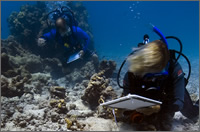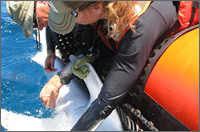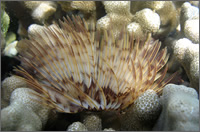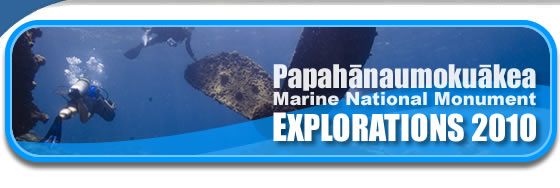Error processing SSI file
|
Papahānaumokuākea Marine National Monument Explorations 2010
On May 10, 2010 a team of fifteen scientists will depart Pearl Harbor in Honolulu, Hawaii, for a 25-day research expedition to Papahānaumokuākea Marine National Monument in the Northwestern Hawaiian Islands. The multidisciplinary expedition will set sail aboard the NOAA ship Hi'ialakai and visit the islands of Nihoa, French Frigate Shoals, Lisianski Island, Pearl and Hermes Atoll, Midway Atoll and Kure Atoll. The scientific party will include a maritime archaeology team, shark researchers, invertebrate and invasive species specialists, ecologists conducting work at maritime heritage sites, and a television newscaster.

|
French Frigate Shoals Whaler (Photo: Tane Casserley)
|
The main objectives of the expedition for the maritime heritage team are to interpret these diverse archaeological sites through underwater mapping, video and photography, and to share their stories with the public in a variety of ways. These kinds of resources tell fascinating stories about hundreds of years of seafaring throughout these atolls. The documentation and interpretation of these sites and their stories will help convey the history of this very remote and special place. The maritime archaeology team will also conduct remote sensing activities in areas where vessels and aircraft were reported lost and to explore for new maritime heritage sites. Tools for remote sensing will include magnetometer and side scan sonar, and will help the Monument build the inventory of maritime heritage sites that tell the story of seafaring in the Northwestern Hawaiian Islands.

|
Melanie Hutchinson holding tiger shark in preparation for implantation of acoustic monitoring tag. (Photo: Jon Dale)
|
Working alongside the maritime archaeology team, a team of ecologists will conduct a biogeographical assessment of maritime heritage sites in the Monument. The scientists are working to understand the way that shipwreck sites interact with the environment, and gain a better grasp of the impact shipwreck sites have upon the ecosystem. This study, initiated in 2009 will help the Monument develop long term monitoring strategies for shipwreck and aircraft sites in the NWHI and serves as an innovative example of the way that we can study maritime heritage sites as part of the coral reef ecosystem.
A continuing study of the movements of apex predator will be conducted by expedition scientists. These specialists will be tagging apex predators such as sharks and large jacks, diving to deploy and retrieve underwater receivers that listen for transmitter equipped predators, and servicing the moorings that anchor their receivers to the bottom.

|
Invert Sabellastarte Spectabilis (Photo: NOAA)
|
Scientists specializing in marine alien species will be working to inventory non-native invertebrates through field collections and surveys. The objective is to better understand the distribution of established alien species and determine if new records exist. This team will also be setting up long term monitoring locations at specific harbor and shoreline locations in the NWHI to better serve the goals of marine alien species management.
Teams will also collect coral and fish specimens for the purpose of analyzing population genetics, part of an ongoing study in the Monument to understand the way that populations in the NWHI are connected to those in the main Hawaiian Islands. All of these diverse projects contribute to the effective management of Papahānaumokuākea Marine National Monument. The scientists conduct daily dive operations to explore, document and collect data, and spend evenings processing data and preparing for the next day’s work. The May-June research expedition to the Northwestern Hawaiian Islands will yield new information that will help to better understand and manage this special place. Follow along as the scientists explore and discover in these remote atolls of the Hawaiian archipelago.
| . . . . . . . . . . . . . . . . . . . . |
|
|
|
|
|
|
|
|
|



